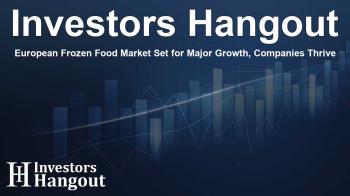European Frozen Food Market Set for Major Growth, Companies Thrive

European Frozen Food Market Set for Major Growth
The frozen food market across Europe is poised for remarkable growth in the coming years, with an estimated increase of USD 62.5 billion from 2025 to 2029. With a projected compound annual growth rate (CAGR) of 7.6%, this sector is becoming increasingly attractive to investors and consumers alike. The desire for convenient meal solutions, coupled with an increased interest in vegan options, is significantly driving this growth trajectory.
Driving Trends in Consumer Choices
Today’s consumers are increasingly focusing on healthy eating habits, which is prompting a surge in demand for vegan frozen food options. As a result, private-label frozen foods are also gaining popularity. This growth is partly attributed to retailers who are allocating more shelf space for their in-house brands and promoting sales within stores.
Shifting Preferences Towards Sustainability
In addition to health considerations, sustainability plays a crucial role in consumer decisions. There is a heightened awareness regarding food waste, pushing retailers and suppliers to enhance sourcing strategies and invest in cold chain logistics. These strategies ensure that frozen food products maintain quality while minimizing environmental impact.
E-commerce Growth Fuels Demand
The rise of e-commerce has also transformed the way consumers purchase frozen foods. With the convenience of online shopping, many are opting to have their groceries delivered. Providers that successfully leverage AI and market insights to tailor their offerings are seeing growth in consumer engagement and satisfaction.
Market Challenges Impacting Growth
Despite its promising growth, the European frozen food market does face challenges. Key among them is the distribution of frozen products across regions, especially in Eastern Europe where adequate cold storage facilities are often lacking. This deficiency can hinder efficient supply chain operations and limit accessibility for consumers.
Quality Control and Food Safety Concerns
The frozen food sector must also navigate stringent food safety regulations. Ensuring that products maintain their integrity is vital for meeting consumer expectations and regulatory standards. This is where technology comes into play as advanced freezing techniques and quality control measures are being adopted to enhance product safety.
Future Outlook for the Frozen Food Sector
The industry is not just about convenience meals; it encompasses a wide range of products including frozen seafood, meats, vegetables, and baked goods. Consumer trends are shifting toward premium options, with a strong preference for high-quality ingredients that promote health and wellness.
Technological Innovations Shape Market Dynamics
As the frozen food market evolves, technology continues to shape its trajectory. Innovations in freezing methods and the use of smart logistics are essential in ensuring that products not only reach consumers effectively but also meet the demands for quality and nutritional value.
Conclusion
The European frozen food market shows no signs of slowing down. With trends leaning heavily towards health, sustainability, and convenience, stakeholders have numerous opportunities to capitalize on this growth. Companies that embrace new technologies and adapt to consumer preferences will be well-positioned to succeed.
Frequently Asked Questions
What is causing the growth in the European frozen food market?
Key factors include rising demand for vegan options, an emphasis on sustainability, and the growth of e-commerce.
How much is the European frozen food market expected to grow?
The market is estimated to grow by USD 62.5 billion from 2025 to 2029.
What challenges does the frozen food industry face?
Challenges include distribution issues, especially in regions that lack adequate cold storage facilities, and maintaining food safety standards.
What role does technology play in the frozen food market?
Technology aids in improving logistics, ensuring quality control, and enhances consumer experiences through e-commerce platforms.
What types of products are popular in the frozen food category?
Popular items include frozen seafood, meats, vegetables, ready meals, and desserts among others.
About Investors Hangout
Investors Hangout is a leading online stock forum for financial discussion and learning, offering a wide range of free tools and resources. It draws in traders of all levels, who exchange market knowledge, investigate trading tactics, and keep an eye on industry developments in real time. Featuring financial articles, stock message boards, quotes, charts, company profiles, and live news updates. Through cooperative learning and a wealth of informational resources, it helps users from novices creating their first portfolios to experts honing their techniques. Join Investors Hangout today: https://investorshangout.com/
Disclaimer: The content of this article is solely for general informational purposes only; it does not represent legal, financial, or investment advice. Investors Hangout does not offer financial advice; the author is not a licensed financial advisor. Consult a qualified advisor before making any financial or investment decisions based on this article. The author's interpretation of publicly available data presented here; as a result, they should not be taken as advice to purchase, sell, or hold any securities mentioned or any other investments. If any of the material offered here is inaccurate, please contact us for corrections.
